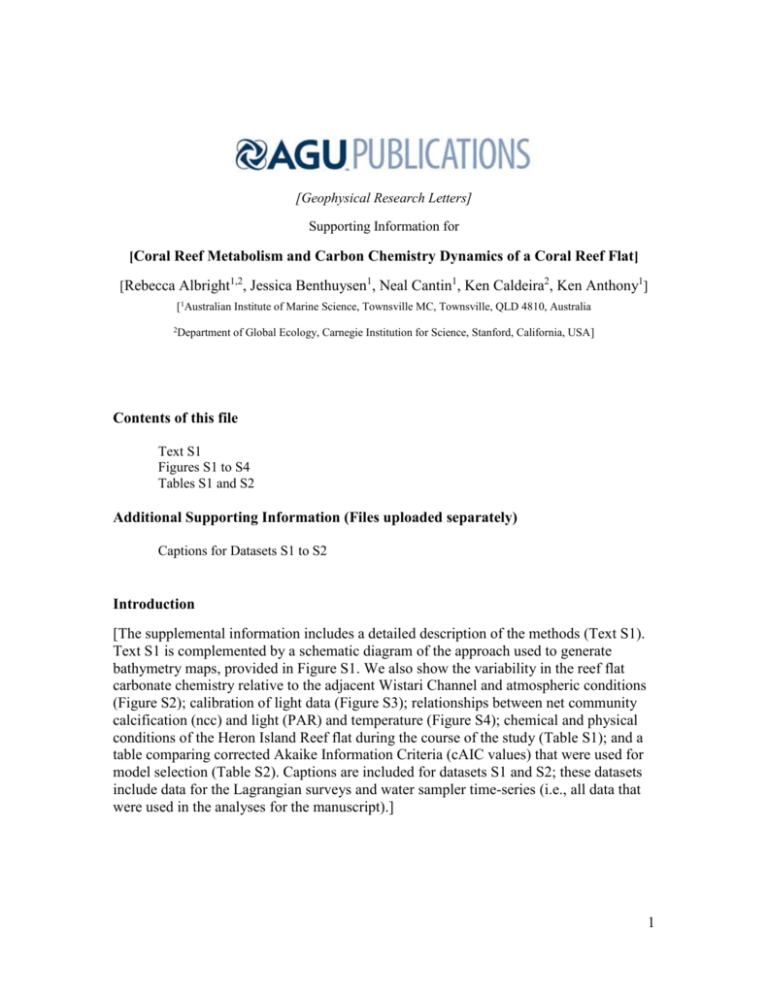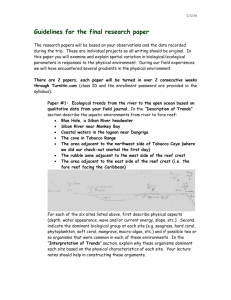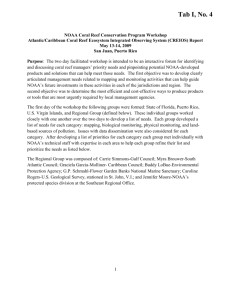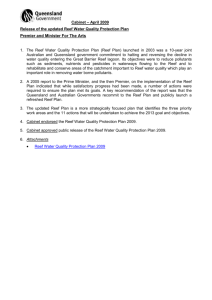grl52923-sup-0001-supinfo
advertisement

[Geophysical Research Letters] Supporting Information for [Coral Reef Metabolism and Carbon Chemistry Dynamics of a Coral Reef Flat] [Rebecca Albright1,2, Jessica Benthuysen1, Neal Cantin1, Ken Caldeira2, Ken Anthony1] [1Australian Institute of Marine Science, Townsville MC, Townsville, QLD 4810, Australia 2Department of Global Ecology, Carnegie Institution for Science, Stanford, California, USA] Contents of this file Text S1 Figures S1 to S4 Tables S1 and S2 Additional Supporting Information (Files uploaded separately) Captions for Datasets S1 to S2 Introduction [The supplemental information includes a detailed description of the methods (Text S1). Text S1 is complemented by a schematic diagram of the approach used to generate bathymetry maps, provided in Figure S1. We also show the variability in the reef flat carbonate chemistry relative to the adjacent Wistari Channel and atmospheric conditions (Figure S2); calibration of light data (Figure S3); relationships between net community calcification (ncc) and light (PAR) and temperature (Figure S4); chemical and physical conditions of the Heron Island Reef flat during the course of the study (Table S1); and a table comparing corrected Akaike Information Criteria (cAIC values) that were used for model selection (Table S2). Captions are included for datasets S1 and S2; these datasets include data for the Lagrangian surveys and water sampler time-series (i.e., all data that were used in the analyses for the manuscript).] 1 Text S1. S1. Material and Methods S1.1. Study Site A diversity of coral species (predominantly Acropora) dominate the fore reef, crest and parts of the outer reef-flat zone at Heron Island. Pavements of crustose coralline algae (CCA) are also abundant on the wave-impacted front of the crest. Mixed zones of branching corals, fleshy and calcareous macroalgae (e.g., Halimeda) dominate the 50– 100m belt behind the crest (outer reef flat). Patches of sand and turfs (reef matrix with assemblages of cropped macroalgae and benthic microalgae) and scattered macroalgae increase in abundance towards the lagoon [Anthony et al., 2013]. S1.2. Mapping of bathymetry and benthic community structure Benthic surveys were conducted to characterize the bathymetry and underlying community structure of the reef flat site. These surveys were conducted over the course of 5 days (March 5, 6, 9, 22, 23) using transects spaced approximately 20 m apart and oriented perpendicular to the reef crest. Each transect was surveyed by 2 divers approximately 3m apart equipped with an underwater camera (Canon S100) and a surface GPS (Garmin GPSmap 76CS x) attached to a weighted depth gauge (UWATEC Aladin Tec 2G, calibrated to 0.1m). The GPS location of each benthic photo and the depth bathymetry along each transect was recorded every 5 seconds. The camera and dive computer clocks were synchronized to the GPS clock to geo-reference benthic photos and depth profiles for each transect. Geo-referencing of each photo was conducted using RoboGEO software (Pretek Inc.). 2 Data from the depth profiles and benthic photographs were used to generate bathymetry and benthic community composition maps of the study site using Matlab. The bathymetry map was used to calculate the average water depth for Lagrangian transects, and the benthic community composition map was used to assess the community composition in the study site. S1.2.1. Bathymetry Mapping A total of 1691 depth measurements were recorded within the study site. The average horizontal spacing ranged from 1 to 2 (m), and we identified 47 individual transects identified by points separated by more than 10 m. To account for differences in tidal height between start and end times of transects (and between transects conducted on separate days), depths were ‘de-tided’ by correcting for the change in tidal height between the start and end of each transect. De-tided depth values greater than zero are areas submerged at the lowest tide, and values less than zero are exposed at low tide (i.e., drying heights) (Figure S1). For each transect, we interpolated the de-tided values onto a regularly spaced grid. For transects with more than 6 points, we applied a low-pass Butterworth filter with an order from 2 to a maximum 8, depending on the number of points, and a cut-off wavelength of 30 m. In order to determine a measure of the local bathymetric non-uniformities in the study site, the low-pass filtered depths, hfilt,detided, were subtracted from the unfiltered depths, hdetided. Then, the total cross-shore depth variance is σh2 (standard deviation σh) e.g.[Feddersen and Guza, 2003] and h 2 N 47 n 1 L x 0 (hfilt,detided ( x) hdetided ( x)) 2 dx N 47 n 1 , L 3 where x is the cross-shore distance from the first point to L, the transect length. From all transects, the cross-shore depth standard deviation is σh = 0.09 m, which is a measure of the bathymetric non-uniformities. Next, we applied an interpolation of the irregularly scattered hfilt,detided data to a finer grid, using a Delaunay triangulation with a natural neighbour method. We used this interpolated grid to determine the mean depth for each Lagrangian drift (according to the start and end coordinates for each drift) by calculating the average of 50 evenly spaced points along each individual transect. We then calculated the mean tidal height contribution (htide) to the water depth for each Lagrangian drift using WXTides32. The total mean water depth is then htotal hfilt,detided htide Over each time period we determined the height variance associated with the varying tidal height and defined it as σt2 (standard deviation is σt). From the 32 traverses, the mean standard deviation owing to tidal height variations is σt = 0.05 m. The total standard deviation for each drift is the square of the sum of the variances: total h2 t2 or 0.1 m. Thus, htotal + σtotal describes the mean water depth over each traverse, when the chemical water sampling was performed, and the uncertainty associated with the spread in depth values owing to tidal variations and bathymetry irregularities. S1.2.2. Benthic Community Structure A total of 890 benthic photographs were analysed using Coral Point Count software with Excel extensions (CPCe) with 20 random points per photograph. The benthos was assigned to one of the following categories: (1) live coral; (2) macroalgae; 4 (3) turf algae; (4) crustose coralline algae (CCA); (5) sand; (6) cyanobacteria; (7) dead coral and/or rubble; (8) zooanthids; (9) and “other” (including invertebrates, sponges, etc.). Where morphologic forms of CaCO3 (e.g., rubble, CaCO3 rock) were covered with biologically active groups (e.g., turf, coralline algae, cyanobacteria), the biologically active group was scored. S1.3. Lagrangian Sampling The net rate at which the community altered the chemistry of the overlying water column was estimated from AT and CT measurements, taking into consideration transit time and water depth (Equations 1, 2). Lagrangian transport was measured by following water parcels using a kayak and/or small boat (dependent on water depth) and a hand-held GPS to record the location of the parcel as it traversed the reef flat (according to Albright et al. [2013]). (All GPS measurements have an accuracy of 2 to 5 m.) Water parcels were identified using fluorescein dye during the day and drifters (40 cm tall and 50 cm wide) at night. Five transects were conducted using both drifters and dye during the day to allow for comparisons between the two techniques. Because drifters often overestimate currents at high wind speeds [Albright et al., 2013; Falter et al., 2008], current speeds for transects that were conducted using a drifter (n=13, 8 night-time transects and 5 daytime transects) were corrected by an average of 18% using the relationship defined in [Albright et al., 2013]. Discrete surface samples were taken in duplicate at the beginning, middle, and end of each Lagrangian transect. Samples were taken in 250 ml borosilicate bottles and immediately poisoned with 125 µl HgCl2 (0.05% by volume) to inhibit biological activity. Average water depth for each transect was calculated using the bathymetric map via the transect location (start and end coordinates) and a tidal signal 5 corresponding to the transect time and duration (refer to Supplemental Information for details). Discrete depth measurements (N=13) were taken for comparison with calculated depths; for discrete measurements, water depth was measured using a hand-held depth sounder alongside of the dye patch/drifter at regular intervals along each transect (typically five measurements per transect) and averaged. Discrete measurements and calculated depths were highly correlated (R2=0.91). S1.4. Chemical Analyses Water samples were analysed for total alkalinity (AT) and total dissolved inorganic carbon (CT) using a VINDTA 3C® (Versatile INstrument for the Determination of Total dissolved inorganic carbon and Alkalinity, Marianda, Kiel, Germany) and a UIC CO2 coulometer (UIC Inc., Joliet, USA). Instrumental precision from 97 certified reference material (CRM) analyses over the course of the study was 2.6 µmol kg-1 (1SD) for AT and 1.5 µmol kg-1 (1SD) for CT. Immediate duplicate analyses of samples usually yielded instrumental precision of < 1 µmol kg-1 for AT and ~1 µmol kg-1 for CT. Measurements and calculations were performed according to Albright et al. [2013] and were consistent with “best practices” recommendations [Riebesell et al., 2010]. S1.5. Physical conditions Temperature and depth were measured continuously at the crest and lagoon water sampler sites using RBR tide gauges (Model XR-420 TG). Discrete water samples were taken during each Lagrangian drift and measured for salinity using a Guildline Portasal Salinometer (Model 8410A). Wind data were obtained from the AIMS Weather Station at Heron Reef (http://data.aims.gov.au/aimsrtds/station.xhtml?station=130). Light was continuously measured at the study site using an Odyssey® photosynthetically active 6 radiation (PAR) sensor that was calibrated to PAR data from the AIMS Weather Station at One Tree Island (Figure S3), approximately 19 km southeast of Heron Island. (The AIMS Weather Station at Heron Island did not have a functioning sensor during the time of our study). Noontime irradiance ranged from 306 to 2248 μmol m−2 s−1, averaging 1150±545 μmol m−2 s−1. Winds were predominantly from the east/southeast and averaged 8 ± 3 m s−1 (mean±SD), ranging from 0 to 20 m s−1. The tidal height ranged from < 0.1 to 2.8 m. S1.6. Calculations Changes in seawater carbon chemistry between upstream and downstream sampling points can be used to calculate rates of net community calcification and net community production. In most coral reef systems, changes in total alkalinity (AT) are caused primarily by calcification and dissolution of CaCO3 whereby two moles of AT are consumed (produced) for every mole of CaCO3 produced (dissolved) (e.g., [Kleypas and Langdon, 2006]). Accordingly, net community calcification, ncc, (mmol CaCO3 m-2 h-1) can be calculated as: ncc 0.5 h AT t (1) where ∆AT is the change in total alkalinity between the upstream and downstream locations (mmol kg-1), ρ is the seawater density (kg m-3), h is the water depth (m), and ∆t is the duration of the transect (h). CT is affected by calcification, dissolution, photosynthesis, and respiration. Net community production, ncp, (mmol C m-2 h-1) was calculated using changes in CT after taking into account ncc and gas exchange: 7 ncp h (CT 0.5 AT ) k s ( pCO2 water pCO2 air ) t (2) where ΔCT is the change in dissolved inorganic carbon between the upstream and downstream locations (mmol kg-1), and the term [ k s ( pCO2 water pCO2 air ) ] approximates gas exchange where k is the gas transfer velocity, s is the solubility of CO2 calculated as a function of salinity and temperature, and ( pCO2 water pCO2 air ) is the difference in pCO2 between the surface ocean and the atmosphere. All other parameters are defined as above. The wind speed parameterization of Ho et al. (2006) was used to calculate k, which ranged 0.9 to 28.7 cm h-1, with a mean of 11.9 cm h-1. Atmospheric pCO2 data were obtained from the PMEL CO2 buoy in Wistari Channel (www.pmel.noaa.gov/co2/story/Heron+Island) and averaged 387 ppm. Resulting gas exchange estimates were small in comparison to ncp, ranging from -0.02 to 0.03 mmol C m-2 h-1. Errors for ncc and ncp measurements (provided in Supplemental Data Set S1) were calculated by propagating standard deviations from depth (0.1 m, see S1.2.1. Bathymetry Mapping), AT (<1 µmol kg-1 for immediate duplicate analysis), and CT measurements (~1 µmol kg-1 for immediate duplicate analysis - see S1.4. Chemical Analyses). 8 Figure Legends Figure S1. Schematic of methodology used to create the bathymetry map of the Heron Reef flat. Measured depths were ‘de-tided’ by subtracting the tidal height at the time of each survey (and correcting for differences in tidal height between the beginning and end of each survey). These ‘de-tided’ depths were used to create a bathymetric map using interpolation and mapping functions in Matlab. De-tided depths that are > 0 represent areas of the reef flat that are submerged by water at lowest astronomical tide or LAT (i.e., ‘charted depths’), whereas de-tided depths < 0 are areas that are exposed to air (i.e., drying heights) at LAT. The resulting map was used to determine water depths for each of the Lagrangian drift by querying the map for the de-tided depth corresponding to the mean depth between the start and end coordinates of a transect, and superimposing a tidal component corresponding to the day and time the drift was conducted. See text below for details. Figure S2. Temporal variability in pCO2 of the atmosphere, and the seawater of the Wistari Channel and the Heron Reef flat over the course of the study. Atmospheric pCO2 and pCO2 of the seawater in the Wistari Channel were measured by the PMEL buoy (www.pmel.noaa.gov/co2/story/Heron+Island). Mean surface water pCO2 (452 ppm) was elevated in reef waters relative to the atmosphere (386 ppm) and the open ocean/Wistari Channel (399 ppm).Reef flat chemistry showed a higher degree of variability than Wistari Channel, demonstrating the capacity of reef metabolism to alter open surface water conditions. Gaps in the reef flat data correspond to periods when the instruments were removed from the reef for maintenance. Figure S3. (a) Relationship between raw (uncalibrated) photsynthetically active radiation (PAR) data from the Heron study site and PAR data from the One Tree Island weather station. This relationship was used to calibrate the Heron PAR sensor (b). One Tree Island light data were sourced from the Integrated Marine Observing System (IMOS). IMOS is supported by the Australian Government through the National Collaborative Research Infrastructure Strategy and the Super Science Initiative. Figure S4. Linear relationships between (a) ncc and light (photosynthetically active radiation, PAR) and (b) ncc and temperature. The weak correlation between ncc and temperature is likely due to the small range of temperatures over which ncc data were collected (25.9-27.6°C). Open circles indicate daytime measurements, and closed circles indicate nighttime measurements. 9 Parameter (units) Salinity* Temperature (°C)* AT (µmol kg-1)* CT (µmol kg-1)* pHtotal pCO2 (µatm) HCO3- (µmol kg-1) CO32- (µmol kg-1) CO2 (µmol kg-1) Ωcalc Ωarag Combined (n=158) 35.4 ± 0.005 35.2-35.5 26.6 ± 0.06 24.2-30.4 2258 ± 2 2176-2307 1969 ± 4 1834-2059 7.99 ± 0.004 7.83-8.14 449 ± 6 281-669 1752 ± 5 1569-1872 205 ± 2 144-261 12 ± 0.2 8-18 4.9 ± 0.04 3.5-6.3 3.3 ± 0.03 2.3-4.2 Crest (n=79) 35.4 ± 0.007 35.2-35.5 26.7 ± 0.08 25.1-30.0 2258 ± 3 2197-2307 1973 ± 5 1837-2046 7.98 ± 0.006 7.83-8.14 457 ± 8 281-669 1759 ± 7 1569-1869 202 ± 2 144-261 12 ± 0.2 8-18 4.9 ± 0.06 3.5-6.3 3.2 ± 0.04 2.3-4.2 Lagoon (n=79) 35.4 ± 0.007 35.2-35.5 26.5 ± 0.09 24.2-30.4 2257 ± 3 2176-2304 1965 ± 6 1834-2059 7.99 ± 0.006 7.88-8.11 441 ± 8 299-601 1746 ± 8 1571-1872 207 ± 3 164-256 12 ± 0.2 8-16 5.0 ± 0.07 3.9-6.2 3.3 ± 0.04 2.6-4.1 Table S1. Chemical and physical conditions of the Heron Island Reef flat (mean ± SE, range). Asterisks denote measured parameters; all other parameters are derived from CT, AT, salinity and temperature using CO2SYS. Calculations were performed according to Albright et al. [2013]. 10 ncp ncp + Ωarag ncp + Ωarag + PAR ncp + Ωarag + PAR + Temp Ωarag AICc 165.55 166.06 168.45 168.89 172.16 Table S2. Corrected Akaike Information Criteria (AICc) values for the relationship between net community calcification (ncc) and various drivers (ranked from lowest to highest). AICc values are for linear models generated in R and fit using generalized least squares by maximizing the log-likelihood. 11 Data Set S1. Data from Lagrangian transects, used to calculate ncc and ncp Data Set S2. Data from water samplers, used to evaluate diel variability in carbonate chemistry 12 References Albright, R., C. Langdon, and K. R. N. Anthony (2013), Dynamics of seawater carbonate chemistry, production, and calcification of a coral reef flat, central Great Barrier Reef, Biogeosciences, 10(10), 6747-6758, doi: 10.5194/bg-10-6747-2013. Anthony, K. R. N., G. Diaz-Pulido, N. Verlinden, B. Tilbrook, and A. J. Andersson (2013), Benthic buffers and boosters of ocean acidification on coral reefs, Biogeosciences, 10(7), 4897-4909, doi: DOI 10.5194/bg-10-4897-2013. Falter, J. L., R. J. Lowe, M. J. Atkinson, S. G. Monismith, and D. W. Schar (2008), Continuous measurements of net production over a shallow reef community using a modified Eulerian approach, Journal of Geophysical Research-Oceans, 113(C7), doi: 10.1029/2007jc004663. Feddersen, F., and R. T. Guza (2003), Observations of nearshore circulation: Alongshore uniformity J. Geophys. Res., 108(C1), 3006, doi: doi:10.1029/2001JC001293. Kleypas, J. A., and C. Langdon (2006), Coral Reefs and Changing Seawater Carbonate ChemistryRep. Riebesell, U., V. J. Fabry, L. Hansson, and J. P. Gattuso (2010), Guide to best practices for ocean acidification research and data reporting. 13







